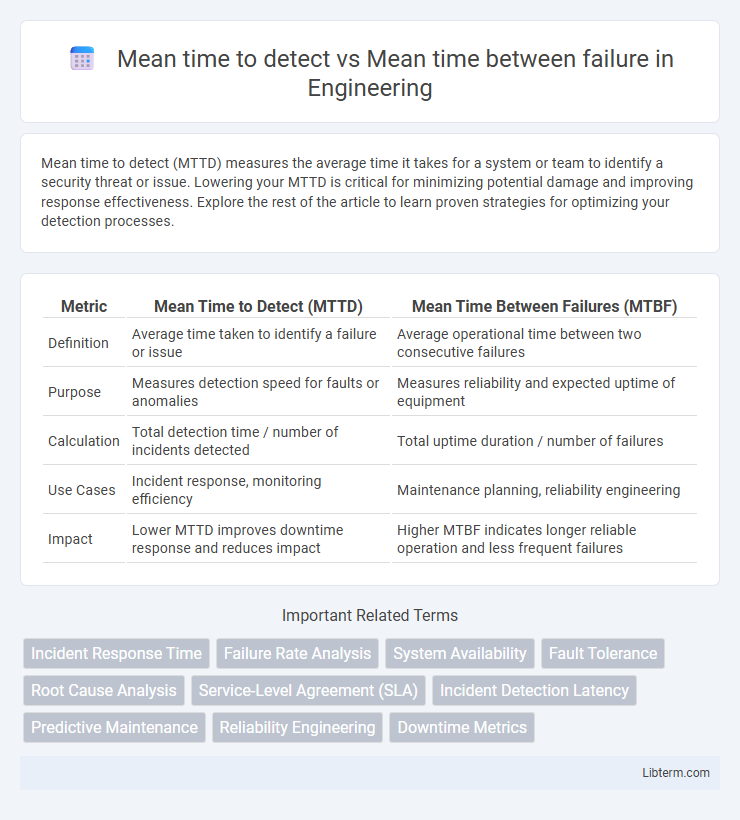Mean time to detect (MTTD) measures the average time it takes for a system or team to identify a security threat or issue. Lowering your MTTD is critical for minimizing potential damage and improving response effectiveness. Explore the rest of the article to learn proven strategies for optimizing your detection processes.
Table of Comparison
| Metric | Mean Time to Detect (MTTD) | Mean Time Between Failures (MTBF) |
|---|---|---|
| Definition | Average time taken to identify a failure or issue | Average operational time between two consecutive failures |
| Purpose | Measures detection speed for faults or anomalies | Measures reliability and expected uptime of equipment |
| Calculation | Total detection time / number of incidents detected | Total uptime duration / number of failures |
| Use Cases | Incident response, monitoring efficiency | Maintenance planning, reliability engineering |
| Impact | Lower MTTD improves downtime response and reduces impact | Higher MTBF indicates longer reliable operation and less frequent failures |
Understanding Mean Time to Detect (MTTD)
Mean Time to Detect (MTTD) measures the average time it takes for a system or team to identify a failure or issue, emphasizing the speed of problem recognition in IT operations and incident management. MTTD is a critical metric for minimizing downtime and improving response efficiency by enabling quicker alerts and faster resolution of incidents. Unlike Mean Time Between Failure (MTBF), which tracks the average time between system failures, MTTD focuses specifically on detection speed, helping organizations reduce the impact of outages through rapid identification.
Defining Mean Time Between Failures (MTBF)
Mean Time Between Failures (MTBF) measures the average duration a system operates before experiencing a failure, serving as a key reliability metric in maintenance and engineering. It is calculated by dividing the total operational time by the number of failures within a specific period, providing insights for preventive maintenance strategies. MTBF contrasts with Mean Time to Detect (MTTD), which focuses on the time taken to identify a failure after it occurs.
Key Differences Between MTTD and MTBF
Mean Time to Detect (MTTD) measures the average time taken to identify a system failure or security breach, while Mean Time Between Failures (MTBF) calculates the average operational time between two consecutive failures. MTTD focuses on detection efficiency and response speed, critical for minimizing downtime and damage, whereas MTBF emphasizes reliability and the longevity of system components. Understanding the distinction aids in improving system maintenance strategies and enhancing overall operational resilience.
The Importance of MTTD in Incident Response
Mean Time to Detect (MTTD) measures the average duration between the occurrence of a security incident and its detection, playing a critical role in minimizing damage and reducing downtime. A lower MTTD enables faster incident response, limiting the impact on system integrity, data security, and business continuity. Unlike Mean Time Between Failure (MTBF), which tracks the average time between system failures, MTTD directly influences the effectiveness of threat mitigation and overall incident management strategies.
The Role of MTBF in Reliability Engineering
Mean Time Between Failure (MTBF) serves as a critical metric in reliability engineering by quantifying the expected operational time between inherent system breakdowns, enabling predictive maintenance and lifecycle management. While Mean Time to Detect (MTTD) emphasizes the speed of failure identification, MTBF focuses on the duration of reliable system performance, thereby guiding design improvements and resource allocation. A high MTBF indicates robust system reliability, reducing downtime and maintenance costs by allowing engineers to anticipate and prevent failures before they occur.
Metrics Calculation: MTTD and MTBF Formulas
Mean Time to Detect (MTTD) is calculated by dividing the total time taken to identify failures by the number of incidents, reflecting the efficiency of detection processes. Mean Time Between Failures (MTBF) is derived from the total operational time divided by the number of failures, indicating system reliability and maintenance effectiveness. Precise calculation of MTTD and MTBF metrics enables organizations to optimize incident response times and improve overall system uptime.
Common Use Cases for MTTD and MTBF
Mean Time to Detect (MTTD) measures the average time taken to identify a failure or security breach, essential for incident response and improving system resilience. Mean Time Between Failure (MTBF) calculates the average operational time between system breakdowns, widely used in maintenance planning and reliability engineering for hardware and software assets. Common use cases for MTTD include cybersecurity monitoring and performance analytics, while MTBF is critical in manufacturing, equipment maintenance, and service lifecycle management.
Impact on System Uptime and Availability
Mean Time to Detect (MTTD) directly influences system uptime by reducing the duration a failure goes unnoticed, enabling faster response and mitigation. Mean Time Between Failure (MTBF) measures the average operational time between failures, impacting availability by indicating system reliability and maintenance intervals. Lower MTTD combined with higher MTBF maximizes system availability and ensures sustained uptime through prompt fault detection and fewer failures.
Strategies to Improve MTTD and MTBF
Reducing Mean Time to Detect (MTTD) involves implementing real-time monitoring systems, automated alert mechanisms, and advanced anomaly detection algorithms that swiftly identify system failures or performance degradations. Enhancing Mean Time Between Failure (MTBF) requires rigorous preventive maintenance schedules, using high-quality components, and conducting thorough root cause analysis to mitigate recurring issues. Integrating predictive analytics with continuous system health assessments significantly optimizes both MTTD and MTBF, leading to improved operational reliability and minimized downtime.
Choosing the Right Metric for Your Organization
Mean Time to Detect (MTTD) measures the average time taken to identify a failure or issue, while Mean Time Between Failure (MTBF) indicates the average operational time between two consecutive failures. Choosing the right metric depends on organizational priorities: MTTD is crucial for teams emphasizing rapid incident response and minimizing downtime, whereas MTBF suits those focusing on improving system reliability and maintenance schedules. Evaluating the impact on service continuity and aligning metrics with business goals ensures effective monitoring and operational resilience.
Mean time to detect Infographic

 libterm.com
libterm.com